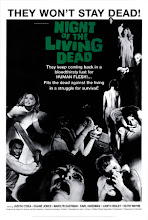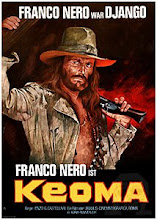 I Walked With A Zombie
I Walked With A ZombieDirector Jacques Tourneur Producer Val Lewton Writers Inez Wallace, Curt Siodmak
Cast James Ellison (Wesley Rand), Frances Dee (Betsy Connell), Tom Conway (Paul
 Good evening and welcome to Schlock Treatment’s special “Schlock Of The Living Dead” zombie triple bill, and a trio of zombie films that are all in black and white, rely on atmosphere over gore, and are considered the classic horrors films of their respective decades.
Good evening and welcome to Schlock Treatment’s special “Schlock Of The Living Dead” zombie triple bill, and a trio of zombie films that are all in black and white, rely on atmosphere over gore, and are considered the classic horrors films of their respective decades.
“Everything good dies here - even the stars.” So says James Ellison’s character Wesley Rand in the 1943 film I Walked With A Zombie as he and Betsy Connell, played by Frances Dee, sail into the port of the tiny Caribbean
 What sets this film apart from the other creaky tinpot spookshows of the Fourties is the sure hand of RKO Pictures producer Val Lewton, renowned for his atmospheric horrors such as Bedlam, Isle Of The Dead and The Body Snatcher. Here in his second horror film after 1942’s The Cat People, he gathers an incredible team - genre specialist Jacques Tourneur (who also helmed Cat People and later directed the brilliant Curse Of The Demon) and writer Curt Siodmak who reworks the story of Jane Eyre into an incredibly literate script which maintains the story’s central mystery to the end. Is the wife suffering from insanity? Or is she truly the living dead?
What sets this film apart from the other creaky tinpot spookshows of the Fourties is the sure hand of RKO Pictures producer Val Lewton, renowned for his atmospheric horrors such as Bedlam, Isle Of The Dead and The Body Snatcher. Here in his second horror film after 1942’s The Cat People, he gathers an incredible team - genre specialist Jacques Tourneur (who also helmed Cat People and later directed the brilliant Curse Of The Demon) and writer Curt Siodmak who reworks the story of Jane Eyre into an incredibly literate script which maintains the story’s central mystery to the end. Is the wife suffering from insanity? Or is she truly the living dead?
 Simultaneously subtle and complex, dreamlike and deeply moral, this is one zombie film here you’re actually glad they don’t pile on the gore. Acknowledged as one of the greatest horror films of the 1940s, Schlock Treatment proudly presents the 1943 classic I Walked With A Zombie.
Simultaneously subtle and complex, dreamlike and deeply moral, this is one zombie film here you’re actually glad they don’t pile on the gore. Acknowledged as one of the greatest horror films of the 1940s, Schlock Treatment proudly presents the 1943 classic I Walked With A Zombie.
aka Night Of The Flesh Eaters
Director George A. Romero Writers John A. Russo, George A. Romero
Cast Duane Jones (Ben), Judith O'Dea (Barbra), Karl Hardman (Harry Cooper), Marilyn Eastman (Helen Cooper)
 Night Of The Living Dead is in essense a seige film like
Night Of The Living Dead is in essense a seige film like
 The importance of this film cannot be understated. Night Of The Living Dead defined a genre and, along with a small handful of films from the 60s such as Psycho, reinvented horror as a genre worthy of attention. Post-modern critics will wax endlessly about the film’s multi-racial cast (including the poor man’s Sidney Poitier, Duane Jones), and its allusions to Vietnam War; semantics aside, it’s a genuinely creepy film, tightly edited and well-acted by a cast of relative unknowns, and intensely claustrophobic, from the line “They’re coming to get you, Barbara” to the ending’s personalized apocalypse.
The importance of this film cannot be understated. Night Of The Living Dead defined a genre and, along with a small handful of films from the 60s such as Psycho, reinvented horror as a genre worthy of attention. Post-modern critics will wax endlessly about the film’s multi-racial cast (including the poor man’s Sidney Poitier, Duane Jones), and its allusions to Vietnam War; semantics aside, it’s a genuinely creepy film, tightly edited and well-acted by a cast of relative unknowns, and intensely claustrophobic, from the line “They’re coming to get you, Barbara” to the ending’s personalized apocalypse.
 The terror is not the result of voodoo ritual but rather something more portentious. Stripped of a supernatural context, the story has a more tangible sense of doom, entropy and decay. It suggests this is the natural order of things - from light into dark, from life unto death. And we the living are to be consumed by what we are destined to become.
The terror is not the result of voodoo ritual but rather something more portentious. Stripped of a supernatural context, the story has a more tangible sense of doom, entropy and decay. It suggests this is the natural order of things - from light into dark, from life unto death. And we the living are to be consumed by what we are destined to become.
Director Victor Halperin Writer Garnett Weston
Cast Bela Lugosi ('Murder' Legendre), Madge Bellamy (Madeleine Short Parker), Joseph Cawthorn (Dr Bruner), Robert Frazer (Charles Beaumont)
 From the time when the names Boris Karloff or Bela Lugosi was sufficient to sell any horror film comes the early genre classic from 1932, White Zombie.
From the time when the names Boris Karloff or Bela Lugosi was sufficient to sell any horror film comes the early genre classic from 1932, White Zombie.
 The title says it all: White Zombie, a stark contrast between the dark mysteries of the
The title says it all: White Zombie, a stark contrast between the dark mysteries of the
 The script and staging may be primitive by today’s standards but the visuals are stunning, considering they were concocted on a shoestring budget at a time horror was in its infancy. Hills dotted with white crosses and dead brides, the vulture as the omnipresent harbinger of doom, and Lugosi’s intense eyes superimposed onto the Haitian countryside, make this a must-see for any serious horror fans. From 1932 we present Bela Lugosi at his intense best in White Zombie.
The script and staging may be primitive by today’s standards but the visuals are stunning, considering they were concocted on a shoestring budget at a time horror was in its infancy. Hills dotted with white crosses and dead brides, the vulture as the omnipresent harbinger of doom, and Lugosi’s intense eyes superimposed onto the Haitian countryside, make this a must-see for any serious horror fans. From 1932 we present Bela Lugosi at his intense best in White Zombie.























































































No comments:
Post a Comment